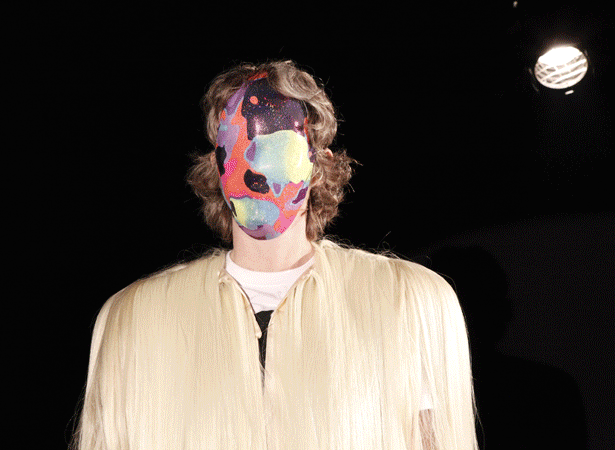
Herman Poole Blount first visited the planet Saturn in 1936. There, he received his calling: quit college and pursue music for one day your vibes will deliver a world in chaos.
By the mid-1950s Blount’s birth date, names, addresses and memories had become opaque, concealing, or perhaps revealing, the accruements of identity as a myth. As Sun Ra, an alien reincarnation of the ancient Egyptian god Ra, Blount conjoined a distant past where Ancient Egypt was the foremost civilization of African people and a near-future in outer space where a colony for black people would once again lead to prosperity. From the terrestrial to the extraterrestrial, earthly to unearthly, Sun Ra’s emancipatory narrative imagined a time and space – an ‘alter-destiny’ – on the other side of white supremacy. (‘Whitey is on the moon,’ Gil Scott-Heron lamented in 1971.)
Sun Ra’s film Space is the Place, directed by John Colney in 1974, provides a complex scenography for ‘Alien Encounters’ at Nottingham Contemporary, an overarching title of four individual exhibitions. Deeply inspired by Space is the Place, Rana Hamadeh has also used ‘Alien Encounters’ as the title of a series of lectures, performances, films and writing she has been making since 2011 in which ‘the alien is seen both as an outcast with regard to the law and as an extraterrestrial’: a figure for the possibility of space that is ‘not subjugated or existing in a secondary relation to some “ground”’.
Titled ‘The Fugitive Image’, the set, props and models of a newly commissioned film-in-progress, The Sleepwalkers (2015), alongside unedited rushes, comprise the latest manifestation of Hamadeh’s series. Filmed on site in Nottingham Contemporary’s theatre, The Sleepwalkers restages and rescripts an American journalist’s account of the confessions of Raya and Sakina, the first two females executed by an Egyptian court of law, in 1921. According to the journalist’s account, a whirling dervish sent into the sisters’ cell elicited a confession by inducing a psychedelic state then periodically dropping trial evidence at their feet. Cast in films as feminine monstrosities, they became somehow symptomatic of moral decline under British colonial rule. In the gallery a dervish’s shimmering, multi-coloured cape hangs by a crown of candles. Hamadeh claims that The Sleepwalkers proposes that justice be viewed as ‘the degree to which one can access the dramatic instruments of representation; i.e. […] theatre’, but it remains ambiguous whether The Sleepwalkers, in fact, functions as a form of reconciliation, temporally lagged justice, for the treatment of these women.
Pauline Boudry and Renate Lorenz’s installation ‘In Memoriam to Identity’ lays to rest, without sentimentality, any fixed ground that might serve as the basis for identity. Projected sequentially on two screens between a bulb-lined, mirrored platform, Opaque (2014) and I Want (2015) are both filmed performances to a camera. In each, dialogue is a swirling sourceless collage. Opaque (an allusion, perhaps, to the American hit comedy Transparent) mashes text by Jean Genet and Edouard Glissant which, though read off-screen, is lip-synced by one performer in drag and spoken by another in a sassy pink zebra print onesie. This zebra print is one of a number of opaque and semi-transparent fabrics drawn back by the performers like stage curtains – a succession of reveals. Finally, both performers ignite lurid-coloured smoke bombs that obscure the view between camera and stage. ‘Opacity,’ Lorenz and Baudry have written, ‘is not just about invisibility, but rather a certain kind of visibility, namely one that does not allow understanding.’
Where curtains, veils and masks preserve an irreducible strangeness in Opacity, no such devices are used in I Want. In this mesmerizing dual-screen film, the artist Sharon Hayes slips seamlessly between re-enacting a performance as the experimental writer Kathy Acker, speaking as the transgender military spy Chelsea Manning, a ‘poet agent’ of a South American liberation army and Jackie Onassis. Who speaks and, indeed, who speaks as whom is uncertain as Hayes drags and transitions – before our very eyes – between first and third person registers and embodiments.
Engorged in whorled Baroque layers of imagery, the centre of Danai Anesiadou’s ‘Don’t commit suicide just because you are afraid of death’ is a family snapshot of the artist as a child. Ancient and modern collapse in lurid ornamentation; around the edges of the gallery are Anesiadou’s belongings – among them Pelican guides to Greece and an Apple MacBook, still lifes preserved in vacuum-pack bags. The religious ceremony she appears to be part of in the photograph is obscured by all this stuff that suggest a stage caught between the living and the dead.
A couple of years ago, Tim Stüttgen’s book, In a QuAre Time and Place (2014), proposed a radical, revisionary reading of Sun Ra’s non-outed gayness through the performance artist E. Patrick Johnson’s notion of ‘quAre’. Johnson complicates the perceived whiteness of ‘queer’ by placing the ‘a’ of black in the centre, thus recalling his grandmother’s usage of the word to describe something ‘odd, irregular or slightly off-kilter’ and the slangy sound sense of black vernacular cultures. ‘QuAre,’ Johnson writes, ‘offers a way to critique stable notions of identity, and at the same time to locate racialized and class knowledges.’ Through Ra and Johnson, Stüttgen tries to think through a tension thinly addressed in ‘Alien Encounters’: complex questions concerning legacies of colonialism, slavery and intersectional queerness; the anti-categorical notion of queer theory and the multi-categorical perspective of intersectionality. The attraction of ‘queer’ among contemporary artists today is a combative identification against white supremacy as a metonym for oppressive power wherever it exists. In Space is the Place, as Sun Ra’s musical-powered spaceship departs planet Earth, the viewer looks back to see it destroyed. With terrestrial ground cleared, those on board are no longer alien to anything.
